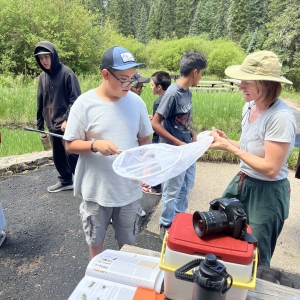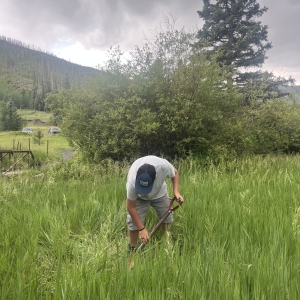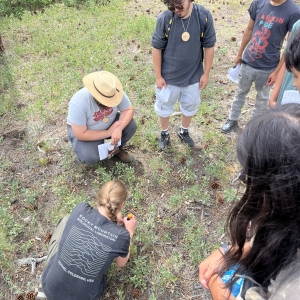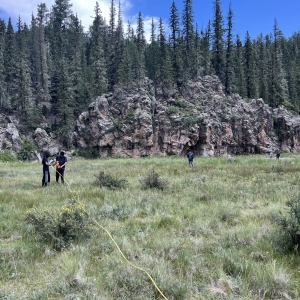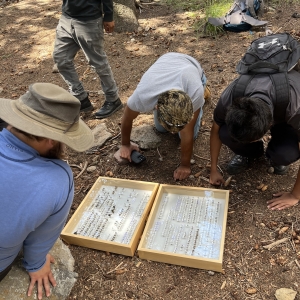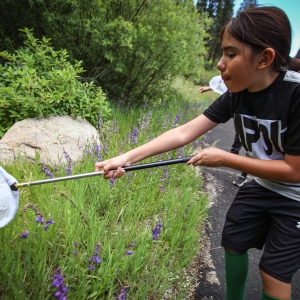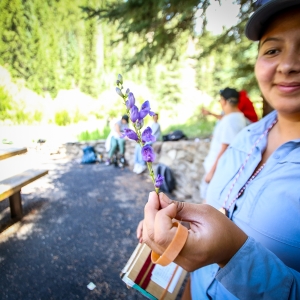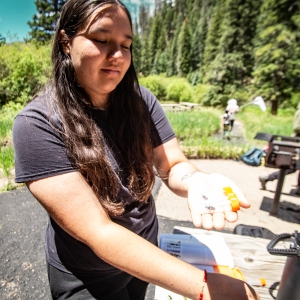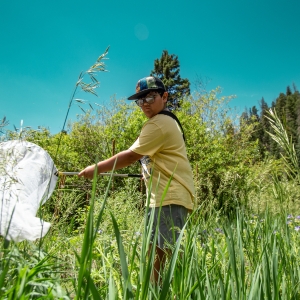Forest Bound 2025: Learning Through Two-Eyed Seeing
by Tanner Johnson, November 2025
The 2025 sessions of Forest Bound were full of curiosity, connection, and the kind of learning that happens when we bring together many ways of seeing the world. We held two full sessions this year: one with the Pueblo of Pojoaque’s Tewa Language Department and the Tewa Roots Society from Nambé Pueblo, and another with a Youth Conservation Corps (YCC) crew hosted by YouthWorks. Both sessions had their own rhythm and focus, but what tied them together was a deep sense of stewardship and belonging to the places we studied.
Rooted in Relationship: Forest Bound with Pojoaque and Nambé Pueblos
Our Pueblo-based sessions brought together about twenty participants of all ages, each one bringing their own lived experience, stories, and curiosity. We spent our time across Santa Fe National Forest, Pojoaque Pueblo, and Nambé Falls Recreation Area, exploring the native plants and ecosystems of northern New Mexico through both ecological science and Traditional Ecological Knowledge.
We were joined by Dr. Greg Cajete (Santa Clara Pueblo) and Chasity Salvador (Acoma Pueblo), two incredible knowledge keepers who shared their deep understanding of plants — from their Tewa names and cultural significance to their uses in ceremony, medicine, and daily life. Seeing participants collect plants for their presses while reflecting on the concept of the Honorable Harvest, as articulated by Dr. Robin Wall Kimmerer, was a beautiful reminder of what Forest Bound strives to be: a meeting ground where Western and Indigenous ways of knowing are placed side by side, not in competition but in conversation. The program is a prime example of the concept of Two-Eyed Seeing, the idea of learning from one eye with the strengths of Indigenous knowledge and the other with the strengths of Western science. Two-eyed seeing naturally aligns with the structure of our Pueblo sessions of Forest Bound. It wasn’t something we had to formally teach; it is inherently woven into how the program works.
Another memorable moment came when Megan O’Connell from the Texas Native Bee Coordination Network and IAE Ecologist, Emily Rees, led us in a native bee survey. Students were thrilled to get up close with these pollinators, discovering firsthand the incredible diversity of bees that call New Mexico home. Their excitement was contagious; there’s something special about watching someone realize how alive a landscape really is.
Later, in a follow-up meeting, the Tewa Roots Society shared something that meant a lot to our team: during their other summer camps, they noticed that participants from Forest Bound couldn’t stop sharing what they had learned. They were identifying plants, telling stories, and passing that knowledge along to others. The skills learned by students during Forest Bound will serve students beyond the session, rippling out into many facets of their lives including future careers. This enduring human impact is exactly what makes this program special.
Growing Stewardship and Skills: Forest Bound with YouthWorks
Our second session this year was with YouthWorks, where we partnered with a YCC crew to focus on job skills, ecological restoration, and environmental stewardship. YouthWorks is a nonprofit organization in Santa Fe that focuses on providing job skills training, degree completion, and job placement for students from vulnerable communities.
Together, we collected seeds of Thermopsis montana in the Santa Fe National Forest and spent time at our Santa Fe office cleaning seeds that will go on to support future restoration projects. We also joined a pollinator survey in the Jemez Mountains, walking transects, identifying the plants that pollinators visited, and recording data like professional field ecologists.
This group was all-in from day one. They connected technical skills with a broader sense of purpose, seeing how their work contributed to real restoration outcomes. Stewardship became more than a concept, it was something they practiced. One student summed up their excitement in a way that still makes us smile: “Nature is low-key gas.”
Beyond the humor, that statement captured what we love about Forest Bound. When young people realize that ecology isn’t abstract: it’s something alive, immediate, and connected to their daily lives, they start to see themselves as part of it. One participant even shared that they now felt more appreciation for urban natural spaces near their home, as well as becoming aware of opportunities to explore public lands in northern New Mexico.
Reflecting on a Year of Growth
Each year of Forest Bound teaches us something new, and this one felt especially significant. The connections participants made to their home landscapes were stronger than ever, and as an educator, I felt more grounded and confident leading the sessions in my second year running the program.
Looking ahead, we’re excited to continue building on this foundation. Thanks to new grants from Environmental Education of New Mexico and the New Mexico Outdoor Equity Fund, we’ll be expanding our involvement with Pueblo communities in 2026, reaching more youth, deepening relationships, and learning alongside our Indigenous neighbors.
Forest Bound continues to grow, not just as a program, but as a community of learners — one where traditional wisdom and scientific inquiry walk hand in hand.
